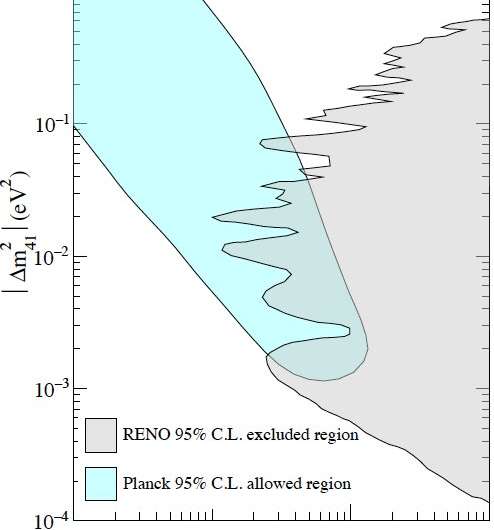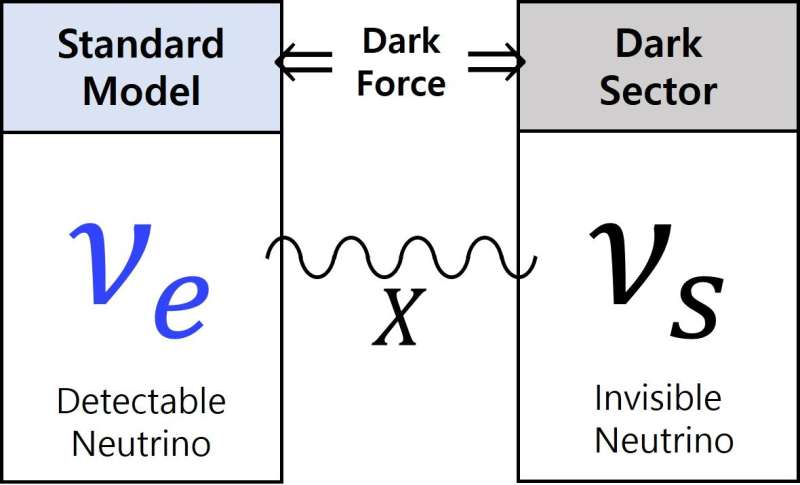December 3, 2020 feature
Searching for sub-eV sterile neutrinos using two highly sensitive detectors

The standard model of particle physics only accounts for 20% of matter in the universe. Physicists have theorized that the remaining 80% is made up by so-called dark matter, which consists of particles that do not emit, absorb or reflect light and thus cannot be directly observed using any existing instruments.
The existence of dark matter is indirectly inferred by astronomical observations of its gravitational effects. So far, researchers have been unable to observe this mysterious type of matter directly, but they have introduced a number of theoretical models delineating possible 'traces' that dark matter could leave when interacting with known standard model particles through unknown forces, also referred to as dark forces.
According to some of these theoretical models, dark matter could be indirectly observed by detecting the effects of its extremely rare interactions with normal matter. Recent astronomical data gathered by the Planck telescope, launched into space over a decade ago and operated by the European Space Agency (ESA), hinted at the existence of an inactive (i.e., sterile) type of neutrino with a mass in the sub-eV-scale, which could be promising dark matter candidates.
The RENO (Reactor Experiment for Neutrino Oscillation) Collaboration, a group of researchers at different institutes in South Korea, recently conducted a search for light, sub-eV sterile neutrino oscillations, which was based on data gathered by two identical detectors located in South Korea over the course of 2200 days. While they were unable to detect these oscillations, their findings, published in Physical Review Letters, could inform future searches for sterile neutrinos.
"Sterile neutrinos, if they exist, may be mixed with active neutrinos and thus leave observable effects in the data gathered in reactor neutrino experiments," Soo-Bong Kim, one of the researchers who carried out the study, told Phys.org. "The experiments of RENO in Korea and Daya Bay in China, which use multiple and identical detectors at the different locations, have sensitivities high enough to test the Planck results."

So far, experimental efforts aimed at detecting hints of sub-eV scale sterile neutrino interactions were unable to pick up signals of these elusive particles. Previous findings thus appear partially to rule out the validity of the recent hypothesis based on data collected by the Planck telescope. To fully confirm or disconfirm this hypothesis, physicists will first need to conduct searches that cover the remaining parameter space, collecting very precise measurements.
In their study, Kim and his colleagues analyzed a vast amount of data gathered by two identical detectors placed at ~300m and ~1400m from six reactors that are situated at the Hanbit Nuclear Power Plant, in Korea. This data was accumulated over the course of eight years, as part of the RENO experiment. The main objective of the RENO experiment is to measure or set a limit on the so-called neutrino mixing matrix parameter θ13, which is responsible for the oscillations that would arise from mixing among different neutrino flavors.
"The large data sample allows us to reduce the uncertainties related to the statistical fluctuations and our two identical detector setup is useful for substantially reducing uncertainties associated with the measurement systems and methods," Kim explained. "They substantially improved the accuracy of the neutrino energy-spectrum measurement. The mixing with unobservable sterile neutrino results in disappearance of active neutrinos in the data, so we tried to probe the sterile neutrino effects by comparing the spectral shapes from the two detectors."
Overall, the recent work by Kim and his colleagues confirms the possibility of conducting dark matter searches using man-made instruments that can measure oscillations with high levels of precision. So far, the researchers were unable to detect any significant features that could result from sterile neutrino interactions. Therefore, their findings suggest that if these particles did exist, their interactions with other particles would be extremely weak.
"The results gathered by us and by the Daya Bay Reactor Neutrino Experiment provide a road map for future precision measurements aimed at detecting sterile neutrino interactions," Kim said. "We now plan to continue the sterile neutrino search in sub-eV scale. In addition, we recently reported the results of an eV-scale sterile neutrino search that showed an interesting indication of mixing with sterile neutrino in the observed neutrino spectra. We plan to continue these efforts using the RENO reactor neutrino complex."
More information:
Search for Sub-eV sterile neutrino at RENO. Physical Review Letters(2020).
DOI: 10.1103/PhysRevLett.125.191801.
Search for sterile neutrino oscillation using RENO and NEOS data. arXiv: 2011.00896 [hep-ex]. arxiv.org/abs/2011.00896
Journal information: Physical Review Letters
© 2020 Science X Network





















